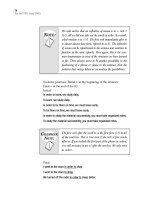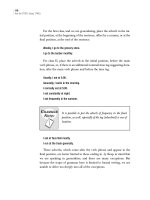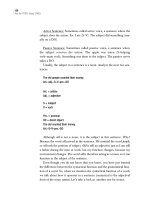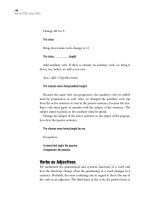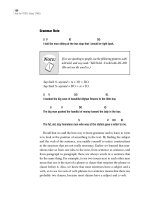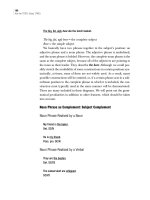Tài liệu Ace the toefl essay part 2 docx
Bạn đang xem bản rút gọn của tài liệu. Xem và tải ngay bản đầy đủ của tài liệu tại đây (137.84 KB, 10 trang )
TOEFL Internals flowed 7/13/07 3:35 PM Page x
Patterns of Development
Simply put, a pattern of development is the method you employ to write
a paper. These patterns are very simple to learn. Fortunately, they do not
take much time, and employing them gives you the advantage needed to
earn that outstanding score on the essay section of the TOEFL.
Understand this: every essay question is worded in such a way that it
requires a specific manner of response. The TOEFL reviewers do not care
about the personal details in your response, but they do look for coher-
ence in your answer. For example, one question from the TOEFL could
ask, “Which would you prefer, a traditional home or a modern home?”
Believe me, no one cares what your personal preference is, but the scor-
er cares if you know that this question requires your answer to be in a
comparison-contrast pattern of development. There are two different
approaches to that pattern, hereafter called a
pod (pattern of develop-
ment)
. Now, let’s look at the process of scoring.
Scoring
The essay is graded by two people. Scores range from 0, for not answer-
ing the question you are given, to 6, the highest possible, which translates
Writing the Essay
PART I:
TOEFL Internals flowed 7/13/07 3:35 PM Page 1
2
Ace the TOEFL Essay (TWE)
to 800. If there is a great difference between the two scores given, a third
grader will be called in. Roughly speaking, if you receive a 4, you are
above average.
Length
The length is 300 to 500 words. That translates to two handwritten pages
or one typed page. The time limit is thirty minutes. Your time and your
length all funnel into a set number of paragraphs for each type of ques-
tion you could encounter. Therefore, set up the essays exactly as I have
presented them, at least regarding the number of paragraphs and the
number of sentences in the introduction of each type of essay.
Presentation
The book contains: (1) a general introduction to the types of pods, includ-
ing outlines for easy reference and fast viewing; (2) a component on punc-
tuation; and (3) real answers to real sample essay questions. In the third
section, you will be given the essay question first. Then, I will identify the
type of question. Next, the possible pods you may use will be listed in
order of importance. For instance, if you see words such as
definition or
comparison-contrast, you should first employ the definition pod. If for some
reason you are blank about how to do that, you can use the comparison-
contrast pod. In addition, if you get halfway through the essay and go
blank, you could rely on your back-up pod, which is comparison-contrast
here, for an additional paragraph. The key is to look at the right words in
the question itself and proceed from there.
TOEFL Internals flowed 7/13/07 3:35 PM Page 2
This chapter deals with rough patterns for essays. These patterns are vari-
able and therefore rough; later on, I include essays that answer specific
TOEFL questions. Look over the outlines carefully, and familiarize your-
self with the various essay elements, such as transitional sentences and
phrases, evidentiary statements (ESs; i.e., ones that provide evidence of
the points you develop in your paper), examples, types of topic sentences
for different pods, types of thesis statements, and finally sentence struc-
ture, which is determined by your pod. Do not be intimidated. You are
capable of earning a 6. Good luck.
(For further explanations, see the list of terms at the end of the
book.)
Comparison-Contrast
When writing a comparison-contrast paper, use words that suggest a rela-
tionship of similarity or dissimilarity, such as
opposite, alike, unlike, in com-
mon
, or any other words with the same meanings. Be aware of signals that
will give you ideas on how to address the topic. The ease with which a
professor, or anyone else for that matter, reads a pod is based on the
reader’s ability to move back and forth from point to point, comparing
CHAPTER ONE:
Essay Formats
TOEFL Internals flowed 7/13/07 3:35 PM Page 3
4
Ace the TOEFL Essay (TWE)
each in a relatively short time. Such a point-by-point structure facilitates
the reading of the pod, but the writing of the pod is usually time-
consuming for the student. However, on the exam, the points are there
and relatively easy to write out. Therefore, I suggest the point-by-point
pod for exams, especially if the exam is only four paragraphs in length.
As a final note, remember that the number of paragraphs in a paper is
directly related to the number of ESs in the introduction. The ES is the
sentence that provides evidence to support your thesis statement (ThS).
The following example, though, features two ESs despite having only
one paragraph in the body. This is a rare exception, and is only com-
mon in a point-by-point pod wherein the two topics are dealt with in the
body of the essay together. It is commonly called an ABAB pod,
because every sentence jumps back to the subject. For example, one
sentence is about A and the next is about B. This allows the reader to
compare the two items fairly well without loss of time, which is impor-
tant to a grader who does a lot of reading.
Let’s look at a point-by-point pod that deals with a tangible subject.
The transitions will be highlighted so that you can see exactly how to glue
the ideas together. First, look at the diagram below. With a point-by-point
pod, you can look at the possibilities in several ways. Primarily, with a
really short paper, the ABABABAB style works, but it fails if you have a
longer paper, say around four to five typed pages. Plus, we do not want
to have a singsong rhythm that becomes monotonous. This style may still
work, but we can apply it to one topic, perhaps encompassing four to five
sentences. Actually, the length is up to you.
The first example of this type of paper is set up in the following format:
AAABBB. The sentences should be equally grouped. For now, look over
the next paper. Note the places where I have written notes to you. I have
highlighted the transitions so that you can observe how we manipulate
our sentence structure, reader attention, and the focus on the content.
This paper is a response to the following essay exam question: Which
would you prefer, an older home or a modern home?
TOEFL Internals flowed 7/13/07 3:35 PM Page 4
5
Essay Formats
Point by Point: Comparison-Contrast
For the individual who puts stock in the old and traditional, the
strength of foundation, and the grandeur of space, the traditional
house may be the choice of a lifetime. [ES1] The motifs of style
that have long been played out in today’s market of prefabricated
homes are existent in those structures that were popular in the
past. In addition, [ES2] foundations were stronger in older hous-
es, and they still are, even given the course of time. For whatever
reason, older homes also tend to be [ES3] larger.
These points
certainly warrant more discussion.
(TR)
Reader: Now, you can write the body two separate ways with the
point-by-point pod. First, you can write the sentences in a point-by-
point format—one sentence about A and one about B—until you com-
plete the category or group of sentences that pertain to evidentiary
statement number one (ES1), the statement that supports the thesis
statement. Therefore, the first motif of style could be written about in
the following manner.
The symbol ¶ indicates the start of a new paragraph, which
includes the indentation, or space, of five letters. The para-
graph below starting with the word
The is indented five
spaces. A space is the size of a letter.
The style of older structures carries the charm of aristocracy or the
peace of the rustic countryside as compared to the assembly-like packag-
ing of modern homes.
A.
Basically, the shopper can choose from a variety in the market of
older structures.
A.
For instance, if one wants to wrap himself in the old world of the
nineteenth century, he can search in the “secondhand” market.
A.
Moreover, the buyer can choose from different time periods, hag-
gle on prices, or even negotiate in the arena of remodeling.
SAMPLE
THE
:
RE
NOTE:
TOEFL Internals flowed 7/13/07 3:35 PM Page 5
6
Ace the TOEFL Essay (TWE)
B. On the other hand, modern homes are thrown up in a hurry,
many having the same features.
B.
Along those lines, most homes in a particular subdivision cost
about the same, so variety is limited.
B.
Consequently, if the buyer wants to stand out in the crowd, the
modern home disallows much personal freedom.
Reader: You should see how the underlined phrases tie the ideas
together, provide contrast among the points, and ultimately guide the
reader. However, we could have set up the body’s format in one para-
graph with the alternating ABAB method.
A
B
A
B
Caution: You should not number or letter the sentences as we did here.
I did that only to give you visual cues so that you see how things are glued
together. Also, do not skip lines unless you start a new paragraph. From the
arrangement of the sentences, we could easily pull out eighteen sentences
from those three points. Writing complete essays will become infinitely
easier than before with these methods. Did you catch how our transitions
were always placed at the beginning of each sentence? It is an excellent
idea to vary the positioning thereof. Let’s go back to the alternating ABAB
method and move the transitions around in the sentences.
For the individual who puts stock in the
old and traditional, the
strength of
foundation, and the grandeur of space, the traditional house
may be the choice of a lifetime. [ES1] The motifs of
style that have long
been played out in today’s market of prefabricated homes are existent in
those structures of yesteryear. In addition, [ES2]
foundations were stronger
in older houses, and they still are, even given the course of time. For
whatever reason, older homes also tend to be [ES3]
larger. These points
certainly warrant discussion.
(TR)
The style of older structures carries the charm of aristocracy or the
peace of the rustic countryside as compared to the assembly-like packag-
ing of modern homes.
Basically
,
the shopper can choose from a variety
TOEFL Internals flowed 7/13/07 3:35 PM Page 6
7
Essay Formats
in the market of older structures. Modern homes, on the other hand, are
thrown up in a hurry, many having the same features.
But, if one wants
to wrap himself in the old world of the nineteenth century, he can search
in the “secondhand” market,
usually finding what he wants in traditional
structures, although doing so may take longer.
A lover of traditional motifs can
choose from different time periods, haggle on prices, or even negotiate in
the arena of remodeling.
Along those lines, most homes in a particular
subdivision cost about the same, so variety is limited.
Consequently, if
the buyer wants to stand out in the crowd, the modern home disallows
much personal freedom.
The preceding paragraph has been changed only slightly, and
this was to accommodate logic. If the paper is short, like a
short essay test, the AB-AB pod is better; however, if the
structure requires time and effort at home, the AAABBB-
AAABBB pod is better. This is the second way to write a
point-by-point pod, which includes writing several sentences
about one point. Notice how the transitions hold it together.
I moved the transition
on the other hand to medial posi-
tion, reworded a sentence, and added a qualifier in italics.
You must employ a variety of sentence structuring techniques
to keep your reader involved. Face it: most people do not
want to hear what you have to say anyway, so be sly; manip-
ulate the reader’s attention, and accomplish your goals.
Refutation-Proof
The next pod is the refutation-proof paper. This pod stands out for tearing
down arguments that have already been made. Also, it’s used as a debating
technique, which attests to its potential effectiveness. The refutation-proof
paper has a very tight structure, but it’s also very flexible, which means
examples, illustrations, and transitions can be integrated within the structure
of the paragraph. To refute means to talk against, and a proof is evidence that
asserts the truthfulness of a statement. So, the refutation-proof paper refutes
T
HE
:
RE
NOTE:
TOEFL Internals flowed 7/13/07 3:35 PM Page 7
8
Ace the TOEFL Essay (TWE)
someone else’s claim and then proves, or provides evidence of, why your
refutation against another’s argument is correct. This is accomplished by
addressing someone’s claim with a series of statements, refuting this
claim, and then explaining why the claim is incorrect, vicariously stating
your stance on the matter in the process. This pod is used in political sci-
ence, many of the social sciences that deal with theoretical arguments, lit-
erature—which may be useful to the students of this text—and almost any
field that involves new developments. Let’s apply this pod to a normal
composition class, regardless of the level. It is quite common for the pro-
fessor to assign specific readings, and, because many students frequently
complain about their inability to come up with a topic to write about, a
midterm or final examination may include an in-class assignment about
the readings. For example, a professor could pick out the argument (main
idea) of a piece and tell the students to comment on that argument, or
there could be five questions to choose from, all including a common
theme about the same topic, each question coming from the same or even
different writers. The student should be prepared for any combination on
an essay exam; therefore, the refutation-proof pod is quite handy to have
in your arsenal.
In the following refutation-proof pod, the introduction summarizes the
other writer’s argument, the argument you will tear down in your paper.
These statements are the ESs in the introduction. Just as in the other for-
mats, the ESs come down, are reworded, and become the topic sentences
of each paragraph. But, in direct contrast to the other formats, the sen-
tences in the remainder of each paragraph tell why the topic sentence is
wrong. Therefore, in essence, the paragraph acts as disclaimer to the topic
sentence. There are two ways to approach this pod from here.
I. ¶ Topic Sentence = your idea how they err (Thesis statement)
1. His idea
2. His idea
Transitional Statement
¶ Topic Sentence (1 = TS [reworded])
A. Your idea
B. Your idea
TOEFL Internals flowed 7/13/07 3:35 PM Page 8
9
Essay Formats
C. Your idea
D. Your idea
Transitional Statement
¶ TS = 2 (His idea, reworded)
A. Your idea
B. Your idea
C. Your idea
D. Your idea
TR Sent.
¶ Conclusion = Summing Up = Your Ideas
II. ¶ Topic Sentence = your idea, Qualify, Sweeping
1. His idea + Qualifier
2. His idea + Q + Adj.
3. His idea + Q + Adj.
4. His idea + Q + Adj.
Transitional Statement
¶ Topic Sent. (1 = TS [reworded])
TS = S + V + Adj. + His idea
A. Your idea
B. Your idea
C. Your idea
D. Your idea
Transitional Statement
¶ TS = 2 (His idea, reworded)
TS = S + V + Adj. + His idea
A. Your idea
B. Your idea
C. Your idea
D. Your idea
TR
¶ TS = 3 (His idea, reworded)
TS = S + V + Adj. + His idea
A. Your idea
B. Your idea
TOEFL Internals flowed 7/13/07 3:35 PM Page 9
